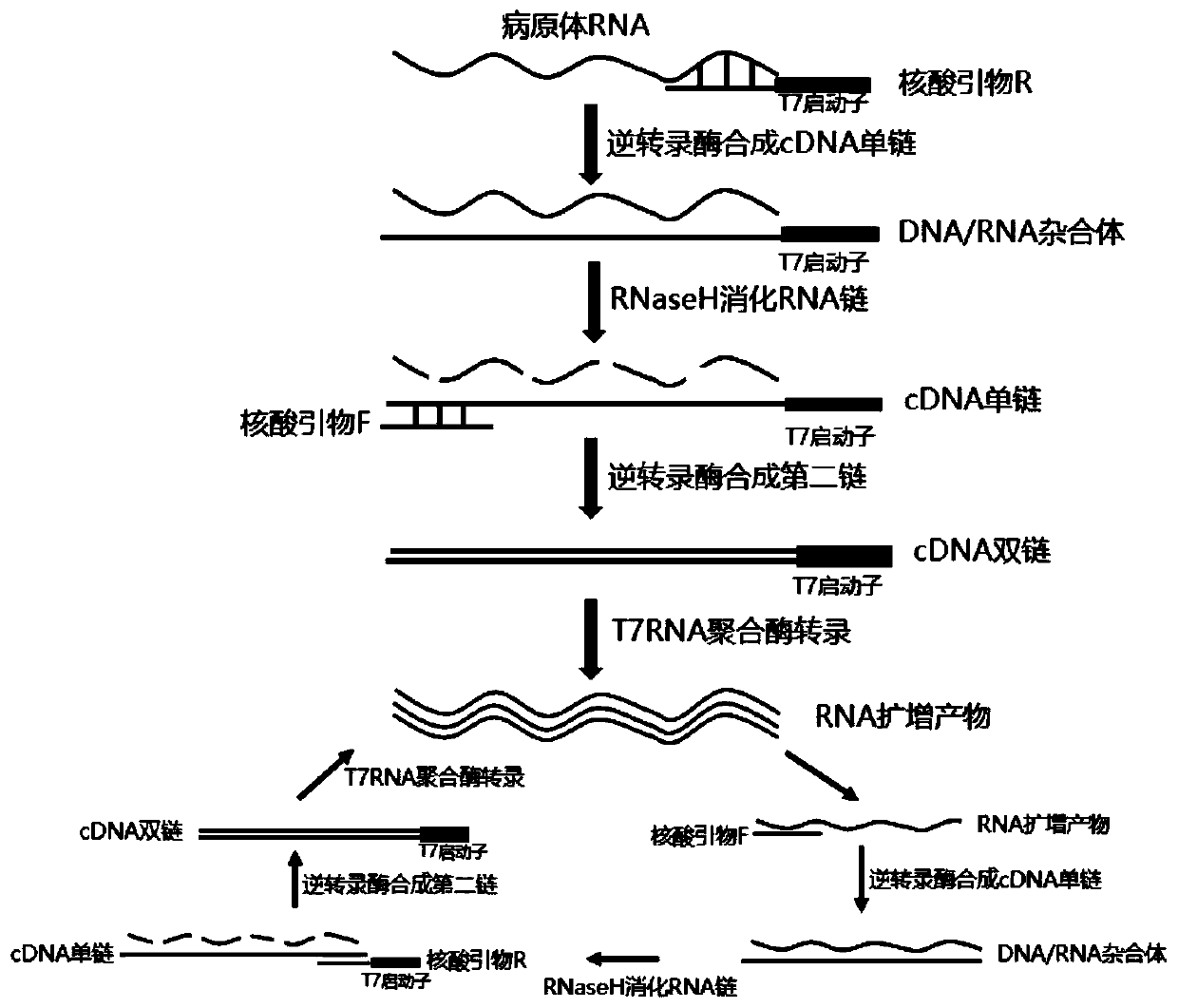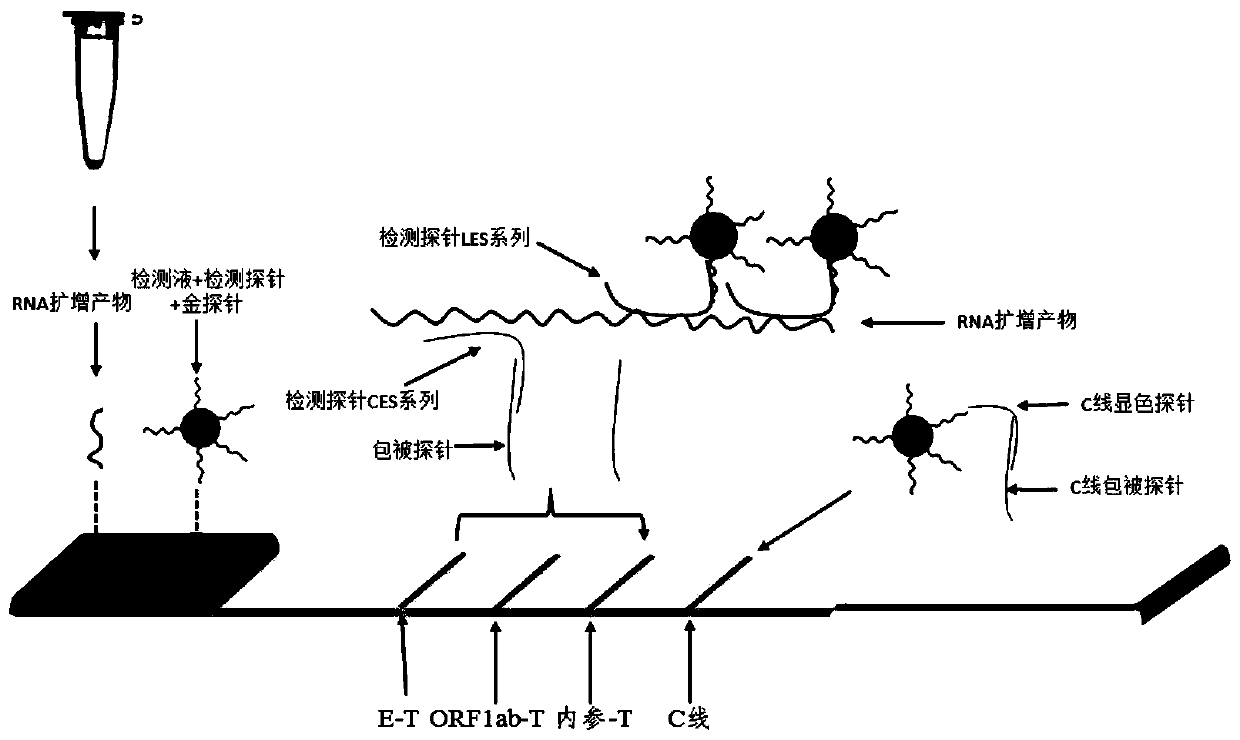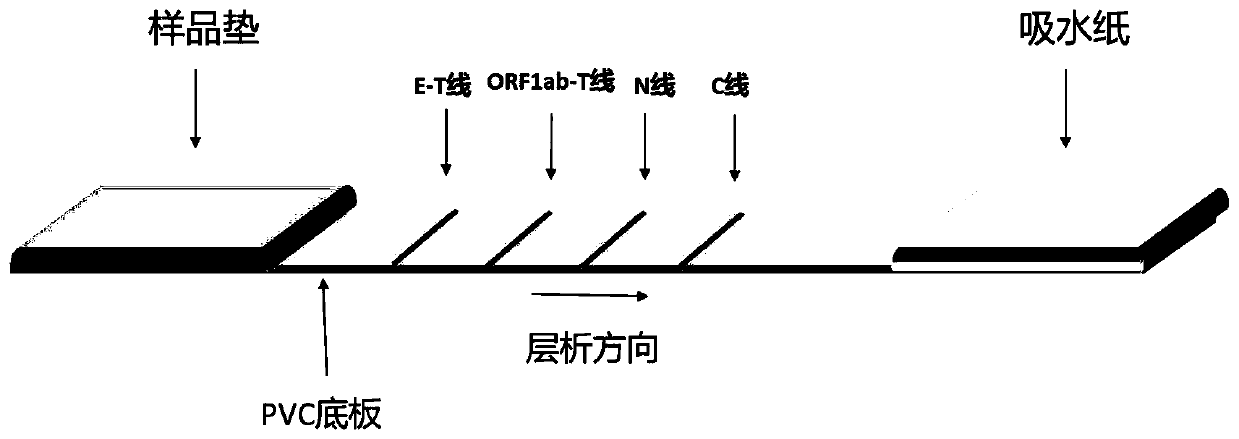Colloidal gold chromatography kit for nucleic acid detection of novel coronaviruses (2019-nCoV) and application thereof
A 2019-ncov, coronavirus technology, applied in the determination/inspection of microorganisms, biochemical equipment and methods, microorganisms, etc., can solve problems such as unfavorable popularization and application, and achieve high amplification efficiency, improved detection efficiency and sensitivity. Effect
- Summary
- Abstract
- Description
- Claims
- Application Information
AI Technical Summary
Problems solved by technology
Method used
Image
Examples
Embodiment 1
[0098] [Example 1] Preparation of nucleic acid detection test strips
[0099] The main raw materials required for the preparation of nucleic acid detection test strips: nitrocellulose membrane (NC membrane), sample pad, absorbent paper, PVC bottom plate, etc.
[0100] 1. Spray film:
[0101] Detection line E-T line: capable of capturing and binding the new coronavirus (2019-nCoV) E gene-specific probe CES sequence, (10μM), spray film volume: 2-3μL / cm;
[0102] Detection line ORF1ab-T line: capable of capturing and binding the CES sequence of the novel coronavirus (2019-nCoV) ORF1ab gene-specific probe (10μM), spray volume: 2-3μL / cm;
[0103] Detection line internal reference-T line: capable of capturing and binding internal reference specific probe CES sequence (10μM), spray film volume: 2~3μL / cm;
[0104] Quality control line (C line): able to capture and bind to the C-line chromogenic probe sequence (10μM), spray film volume: 2-3μL / cm;
[0105] After spraying the film, it...
Embodiment 2
[0108] [Example 2] Sensitivity Test
[0109] Select a known concentration of the pseudovirus containing the 2019-nCoV target gene, perform a 10-fold concentration gradient dilution, and repeat each gradient dilution three times separately, and use the lowest dilution concentration with a 100% positive detection rate as the estimated detection limit , after the estimated detection limit is determined, dilute the 2019-nCoV pseudovirus to near the estimated detection limit concentration, and use the kit for detection, each concentration is tested 20 times to further accurately determine the minimum detection limit concentration (the positive rate is selected at The dilution above 95% is used as the detection limit sensitivity of this kit).
[0110] Table 1. 2019-nCoV Pseudovirus Experimental Results - Determination of Estimated Detection Limits
[0111]
[0112] Table 2. Experimental results of 2019-nCoV pseudovirus - determination of detection limit
[0113]
[0114] ...
Embodiment 3
[0116] [Example 3] Specificity Verification
[0117] Other pathogens that are similar to the 2019 novel coronavirus species or cause similar symptoms (such as seasonal influenza A H1N1 virus, novel influenza A H1N1 (2009) virus, influenza A H3N2, H5N1, H7N9, influenza B Yamagata, influenza B Influenza type Victoria, RSV type A, RSV type B, parainfluenza type I, parainfluenza type II, parainfluenza type III, rhinovirus group A, B, C, adenovirus 1, 2, 3, 4, Types 5, 7, 55, enterovirus A, B, C, D, human metapneumovirus (human metapneumovirus), Epstein-Barr virus, measles virus, human cytomegalovirus, rotavirus, norovirus, Mumps virus, varicella-zoster virus, Mycoplasma pneumoniae, Chlamydia pneumoniae, Legionella, Bordetella pertussis, Haemophilus influenzae, Staphylococcus aureus, Streptococcus pneumoniae, Streptococcus pyogenes, Klebsiella pneumoniae, tuberculosis Mycobacterium, Aspergillus fumigatus, Candida albicans, Candida glabrata, Cryptococcus neoformans, coronavirus (HK...
PUM
 Login to View More
Login to View More Abstract
Description
Claims
Application Information
 Login to View More
Login to View More - R&D
- Intellectual Property
- Life Sciences
- Materials
- Tech Scout
- Unparalleled Data Quality
- Higher Quality Content
- 60% Fewer Hallucinations
Browse by: Latest US Patents, China's latest patents, Technical Efficacy Thesaurus, Application Domain, Technology Topic, Popular Technical Reports.
© 2025 PatSnap. All rights reserved.Legal|Privacy policy|Modern Slavery Act Transparency Statement|Sitemap|About US| Contact US: help@patsnap.com



